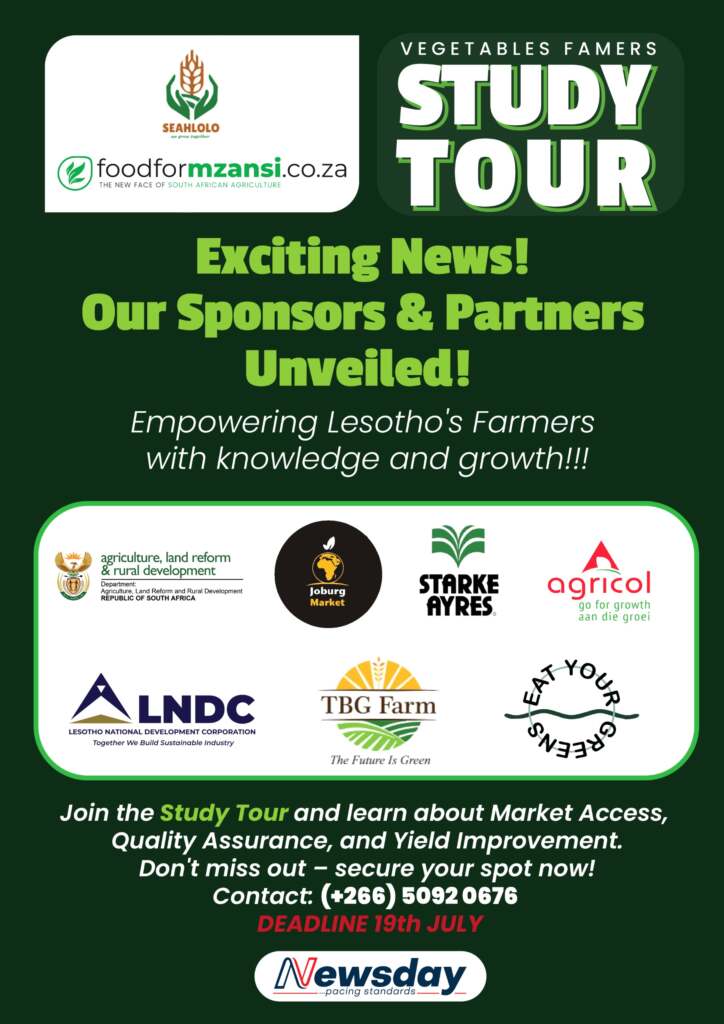Lerato Matheka
In a resounding commitment to agricultural development, the government of Lesotho has earmarked a substantial budget of M1.3 billion.
This financial allocation reflects the nation’s determination to bolster the backbone of its economy and foster sustainable growth in the agricultural sector.
Finance and Development Minister, Dr Retšelisitsoe Matlanyane, outlined the vision for the coming years, anticipating a steady growth trajectory, with agriculture playing a pivotal role alongside key sectors like technology and infrastructure.
In the face of climate change challenges, the minister emphasised the government’s resilience and adaptability to ensure continued stability and progress.
Agriculture, often dubbed the cornerstone of Lesotho’s economy, has been allocated a robust budget of M1.3 billion.
Minister Matlanyane highlighted the need for a comprehensive agriculture transformation support program, addressing key aspects such as extension services, data collection, finance accessibility, irrigation infrastructure, and value addition.
“The time has come for Lesotho to implement a comprehensive agriculture transformation support programme to improve both production and productivity for our agricultural sector. This programme will include enhancing extension services support to farmers, improving agricultural data collection efforts, facilitating access to affordable finance, improving irrigation infrastructure footprint, supporting agricultural value addition activities as well as storage and logistics,” Matlanyane said.
The government’s unwavering commitment to agricultural development is evident in upcoming projects, including the Intensive Crop Production program and the Wool and Mohair Value Chain Competitiveness Project. These initiatives are meticulously designed to enhance sustainable food security and elevate farmer engagement.
Millennium Challenge Account (MCA) Lesotho is set to inject $118 million (LSL 2,301 billion) over the next five years into agriculture.
This significant investment according to Matlanyane aims to support the development of commercial horticulture in key irrigation schemes, fostering partnerships with local Small Holder Farmers (SHF) and landowners.
“The initiative is poised to boost horticulture production, create jobs, and reduce dependence on imports.”
The budget allocation breathes life into the mid-term budget performance of the agriculture ministry. With M160 million dedicated to combating hunger, ensuring food security, and supporting sustainable agriculture, the government has already facilitated the procurement of inputs worth M51 million.
Critical irrigation schemes in Tsitsong, Nkh’unkh’u, Makoabating, and Thaba-Phatšoa have been rehabilitated, contributing significantly to agricultural growth.
To ensure a successful winter crop yield, the government initiated a strategic program involving the cultivation of wheat through block farms in key regions. Plans for the establishment of block farms across the country are in the pipeline, aiming to boost agricultural yields and contribute to economic prosperity.
In the livestock sector, establishing an advanced Artificial Insemination Centre in Quthing marks a pivotal development. This move is expected to revolutionize local wool and mohair production, contributing significantly to regional prosperity.
The increased budget allocation is a strategic response to Lesotho’s food security challenges, aggravated by the anticipated El-Nino induced drought from October 2023 to December 2024. Humanitarian assistance is already a pressing concern, with approximately 521,000 people in need, according to the Vulnerability Assessment Report of 2022.
In the previous ploughing season, the government engaged in block farming to boost cereal production, with an 80% government and 20% farmer-sharing ratio. The Intensive Crop Production (ICP) subsidy program, backed by M315,177,486.90, subsidized fertilizer, seed, and herbicides, promoting investment in agriculture.
As Lesotho forges ahead, this substantial budget allocation to agriculture stands as a beacon of hope, signalling a brighter and more prosperous future for the nation’s farmers and the entire agricultural landscape.




